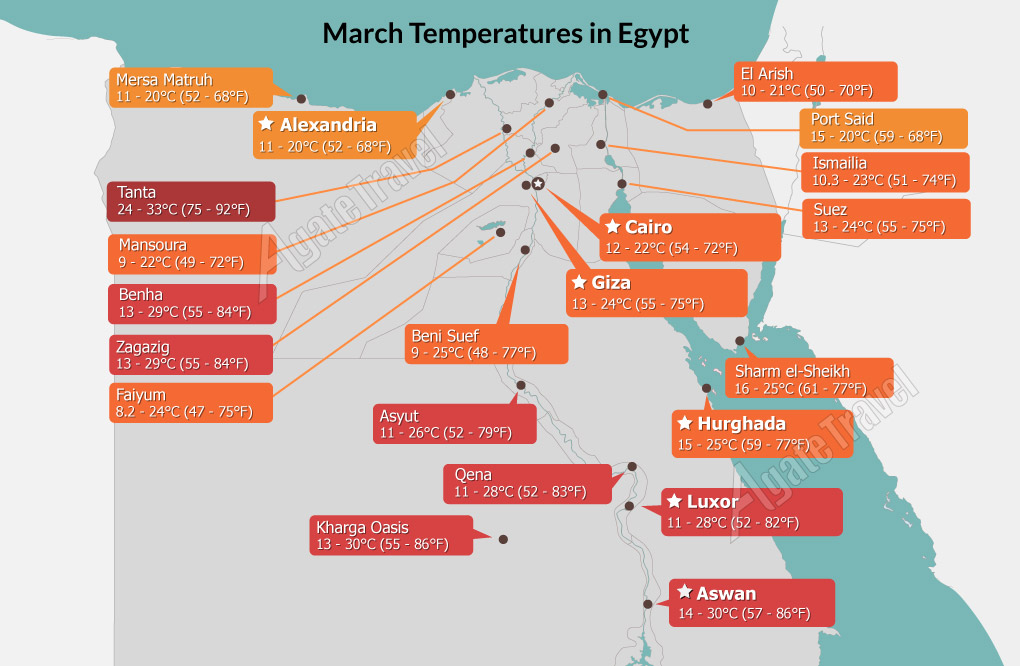Egypt is famous for its hot desert climate (BWh), characterized by dry air, intense sunshine, and minimal rainfall. The weather is influenced by its vast deserts, the Mediterranean Sea to the north, and the Red Sea to the east. Throughout the year, Egypt enjoys clear skies, making it a year-round destination but with important seasonal differences to consider.
Seasons in Egypt
Winter (November – April)
Mild and pleasant during the day, ideal for sightseeing.
Occasional cold spells and light frost in the Nile Delta and northern Nile Valley.
In the Western Desert, nights can drop below freezing.
Coastal temperatures average 22–25°C in the day and 15°C at night.
Popular season for exploring temples, cruising the Nile, and desert tours.
Summer (May – October)
Hot and dry, with temperatures in most areas reaching 40°C (104°F) or higher.
Inland desert regions like Luxor and Aswan often exceed 41°C, with some heatwaves pushing past 46°C.
Large temperature swings in the desert: 7°C at night to 43°C by day.
Coastal cities remain slightly cooler thanks to northwesterly winds from Greece, but the sun remains intense.
Rainfall in Egypt
Most regions receive less than 80mm of rain annually.
Alexandria and the northern coast see more, averaging 200mm/year, mostly in winter months.
Red Sea resorts such as Marsa Alam, El Qoseir, and Sharm El Sheikh may get occasional light showers in cooler months.
Other Climate Influences
Humidity
Low humidity dominates Egypt, especially in desert regions.
Alexandria is more humid due to the sea, but cooling breezes keep it comfortable.
Khamsin Winds
Between March and May, the Khamsin blows from the south/southwest.
Brings hot, dry, sand-filled air that can raise temperatures above 50°C and drop humidity to below 5%.
Often causes sudden, dramatic heatwaves and reduced visibility due to dust.
Temperature Variations
Coastal areas: moderate year-round.
Nile Valley & Delta: warm to hot with less extreme changes.
Desert areas: sharp day-night shifts, sometimes over 20°C difference.
Regional Climate Overview
Coastal Areas (Mediterranean & Red Sea): More humid, slightly cooler, and receive more rainfall than inland. Red Sea resorts enjoy sunshine almost all year.
Nile Valley & Delta: Moderate temperatures, fertile lands, and Egypt’s population hub.
Western & Eastern Deserts: Hot, arid, and extreme temperature differences between day and night.
Best Time to Visit Egypt
October – April: Ideal weather for most activities.
March – April & October – November: Shoulder seasons with warm days, cooler nights, and fewer tourists.
Avoid mid-summer (July–August) in Upper Egypt due to extreme heat.
Travel Tips for Weather Preparedness
In summer, explore early morning or late afternoon to avoid peak heat.
Wear light, breathable clothing, sunscreen, and a hat year-round.
In desert areas, carry layers for cool nights.
Stay hydrated, especially when visiting Luxor, Aswan, or desert attractions.
Final Word:
Egypt’s climate makes it a land of sunshine and contrasts—from cool Mediterranean breezes to scorching desert heat. By planning your visit around its mild seasons and understanding its unique weather patterns, you can enjoy everything from ancient wonders to Red Sea beaches in complete comfort.

